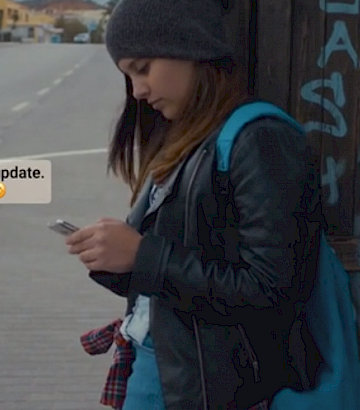Videos
Explanation
The videos presented correspond to different aspects of the topic of intimacy.
Educational objectives
- Using the videos, reflect on various issues that affect intimacy (e.g.: emotional intimacy, first sexual relations, consent, prevention of STBBIs, etc.) and, in particular, online intimacy (e.g.: cyberpornography, sexts, sextortion, etc.).
- Understand these issues by situating them in the learning and transition period that is adolescence.
- Become aware of the different ways to preserve your intimacy, your limits and to respect those of others.
Progress
Before the activity
- Learn about the videos and select those that are appropriate for your young people.
- Read the Stimulus questions and What stands out sections for each of the selected videos.
- Take note of the Key message.
- Print the necessary material as needed (What stands out, Stimulus questions, Closing questions, and key message)
- Plan rules of conduct that the youth will have to respect (eg, speaking out, respect for others, self-respect, etc.)
During the activity
- Present a video.
- Ask, in the main group, what stands out the most from the video? (Refer to What stands out)
- Ask the Stimulus questions that are related to the video.
- Repeat these three steps for each video presented.
- At the end, you can ask the Closing questions and finish the workshop with the Key message.
Equipment
- a computer (in a small group)
- a computer + backdrop + projector (in the main group)
and if necessary,
- The printed What stands out
- The printed Stimulus questions
- The printed Key message
Emotional intimacy
What stands out
- Several duos are invited to look into each other's eyes, sitting for 4 minutes without saying anything. The individuals who participate in this experience are in different types of relationships.
- Supporting someone's look allows one to get closer to the other - without physical closeness - and to experience another form of intimacy. Thus, simply looking for 4 minutes can be an intense moment, considering that the look makes it possible to connect to the other person (e.g.: nonverbal communication). It can be difficult to support such a look and simply surrender to it.
- In this context, the other person's gaze says a lot (e.g.: eyes that twinkle, smiles, tears in the eyes, etc.) and emotions are experienced more intensely
Stimulus questions
What do you think of this video?
In your opinion, are there different types of intimacy? If yes, which ones? If not, why?
- Intimacy is when you and another person share your feelings and emotions, revealing to one another through your actions or words. You trust them, you feel good.
- You can share a greater intimacy with close friends or family members, who are your confidants, whom you trust and who make you feel good. It can also be with a lover where you feel very close and united to this person. You may want to explore sexuality at your own pace, to share sexual intimacy.
- So, yes, there are several types of intimacy. A personal, family or friendly intimacy. Also, there is a romantic and sexual intimacy.
From: Campanelli, N. (2006). Intimacy in adolescent sexual relations: The distinctive features of orogenital relations, The SexEducator. Flagged at http://publications.msss.gouv.qc.ca/msss/fichiers/2005/05-314-03A.pdf
First sexual relationships
Whats stands out
- We talk about the first sexual relation by making an analogy with "eating spaghetti"; a humorous way to relieve the pressure, to reassure, to relativize the overly idealized situations of the first time.
- A side note: Be careful not to overemphasize that "the first time" can be disappointing ... Even if the message says it does not matter: « it's only ''eating spaghetti"’ ». Also, mention that THE first times (and not just the first time) can be simple and enjoyable to the extent that one does not expect sexual performances from either side.
Stimulus questions
What do you think of this video ?
What are the fears of kids your age relative to the first sexual relations?
- The fear of disappointing or being disappointed.
- The fear that it hurts or of hurting.
- The fear of not knowing exactly what to do, being inexperienced and looking ridiculous.
- The fear of being laughed at.
- The fear of getting a sexually transmitted infection, becoming pregnant (or having a partner become pregnant).
- The fear of having to do like in porn movies.
All these fears are understandable and can take up a lot of unnecessary space if young people don't have the chance to name them, to discuss them and to differentiate what is real from what is fake to reassure themselves. Certainly, we must not believe that we must do everything the first time. Tell yourself that the other person also has their fears and that being able to talk about them will make your experience more enjoyable and less stressful.
Cyberpornography
What stands out
- Pornography is the first topic on search engines on the Internet.
- Pornography has changed in recent years, it can shape our sexual tastes and desires.
- Science sheds light on the effects of pornography, particularly on the brain and what can be done to reverse its potential negative effects.
Stimulus questions
What do you think of this video?
What do you think can be done to avoid or reduce the negative effects of cyber-pornography?
- Be critical of cyberpornography.
- Pornography shows, but does not teach us how to feel. Generally in life, but also in more intimate moments, you have to learn to feel things, to take your time and enjoy the little moments of pleasure. In the same way, sensuality makes it possible to discover or rediscover pleasures related to the senses (e.g.: smell, touch, hearing, taste, and sight).
- Don't confuse sexual relations with "sexual contacts". During a sexual relationship, the person is "connected" with the other: with their personal history, their modesty (shyness), their desire, with what this person is, etc. This is not sexual acrobatics or a list of sexual practices to perform.
Consent
What stands out
Consent and Tea
- Analogy of consent between receiving a cup of tea and receiving a sexual act with or without physical contact. It's a nice analogy to understand that you can't force anyone to engage in sexual activity and that we must ensure consent and not predict what the other person wants. They have the right to refuse, to change their mind, or may not be in a state to consent and at that moment, we must accept it.
Rape drug
- During a drunken evening, we witness a seduction operation between Simon and Clara. The latter, although smiling, shows nonverbal signs of disinterest.
- Simon escorts Clara, who is intoxicated, and kisses, undresses and fondles her despite her intoxication and her inability to give consent.
- We see him questioning his gesture and giving himself some excuses for having a non-consenting relationship with Clara.
Stimulus questions
What do you think of this video?
In your opinion, what are the signs that tell us that Clara can't consent to having sex?
She is so intoxicated that she is almost unconscious. It's obvious that she can't give her consent.
Alcohol and drug use can alter our judgment. The person can be drunk (effect of substances) - without being almost unconscious - and also be in a situation where they can't give their consent.
What do you remember from Simon's reflections? Can you name a few important messages?
- It's not because a girl accepts your drinks that she's interested in going out or sleeping with you.
- It's not because a girl dances in a sexy way that she's open to sex.
- It's not because a girl stumbles into your arms that she wants you (too intoxicated).
Therefore, a person intoxicated by any substance (alcohol, rape drug, cannabis, etc.) cannot give informed consent for sexual intercourse. To intoxicate a person to have sex is a sexual assault.
Sexting & Sextortion
What stands out
- Essentially, the message is to not send sexts; the consequences are numerous, besides it being illegal to share sexts of people under.
Stimulus questions
What do you think about these videos?
For kids your age, what are the disadvantages of sending and receiving sexts?
- Wanting to send and receive a sext from someone you love and trust is legitimate. This sharing of intimacy between two people can be a way of showing one's desire for the other. Anything you send can be kept on the other person's device. Right now, you probably appreciate this person and you trust them completely. What will happen if you leave and that person has nude pictures of you on their phone? Maybe they will respect you and remove them from their phone. However, they can also show them to other people and/or share them on social networks. They can say that sharing sexts is so common that it doesn't bother anyone anyway. Don't forget that it's not your fault if the other person shares the sexts you sent them. It is entirely the other person who has the power to share these sexts and no valid reason justifies this behavior.
From: Johnson, M., Mishna, F., Okumu, M, and Daciuk, J.; MediaSmarts. (2018). Non-Consensual Sharing of Sexts: Behaviours and Attitudes of Canadian Youth.
Flagged at http://mediasmarts.ca/sites/mediasmarts/files/publication-report/full/sharing-of-sexts.pdf
Prevention of STBBI
What stands out
1st video
Video based on a survey of the sexual health of 3,000 Quebec youths aged 17 to 25.
- Nearly half of young people who have sex don't consider themselves at risk for chlamydia.
- 1 in 10 say they have been diagnosed with chlamydia
- Few young people were tested in the last year, more women than men were tested.
- Among those who have multiple sexual partners, 4 out of 10 have been screened.
- Main difficulties related to screening: fear of having a positive result, fear of the judgment of others, discomfort with discussing sexual relations with a nurse or a doctor.
Stimulus questions
What do you think of these videos?
Plenary
Closing questions
Following the presentation of different videos, what do you remember from this exercise?
In your opinion, are there other contexts where it is pleasant and respectful to share one's intimacy?
- There are indeed other contexts in which it's nice to share one's intimacy with someone, as long as one feels confident and respected. To the extent that this person has already demonstrated their discretion, sensitivity, and respect for us and others, it may be nice to share their intimacy.
Similarly, are there other contexts where there is a risk of sharing one's intimacy and that it can derail?
- Some people don't realize the impact of revealing personal information about themselves, or about others, to other people. It also happens that some people exploit the naivety or the situation without feeling responsible for their actions. Don't hesitate to talk about it when you're not sure if what happened is okay or not. In some cases, it is illegal and we need help to see things more clearly.
Key messages
When intimacy carries us :
- Intimacy can be as simple as looking someone in the eye while trying to connect with their emotions. When we share a great emotional intimacy with someone who pleases us, we feel comfortable to confide our emotions and our fears, and we feel confident. Intimacy, though it may include sex, is not limited to that. Finally, intimacy is being able to reveal oneself to each other, respecting the limits of each and at their pace.Moreover, it is often more pleasant and safer to explore one's sexuality with someone with whom one has developed an emotional intimacy before developing a sexual intimacy.
When intimacy derails:
- As we have seen, intimacy is precious. Some people reveal themselves very quickly to people they have recently met (e.g.: secrets, privacy, etc.), whether in person or on the Internet.
- One may be tempted to use the Internet and social networks to seduce, go out or hang out with someone, sharing an "online" intimacy because it's accessible, easy to use and often reduces the feeling of shyness that can be had when meeting the person for "real". Whether "online" or not, sharing one's intimacy carries some risk, because unfortunately, one can never know what the other person could do, now or in the future, with secrets, photos and/or videos that have been shared, even in the context of a romantic relationship.
- Indeed, some believe that to share intimacy with someone, one must quickly share "sexts" or have sexual activities with that person. It should be remembered that one of the key elements in a healthy intimate relationship is respect for the boundaries of both people and consent.











